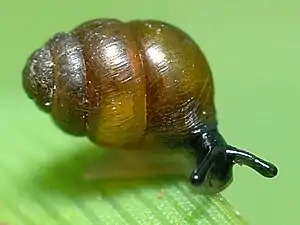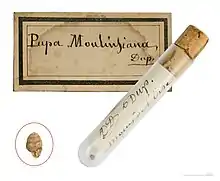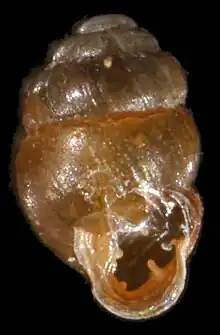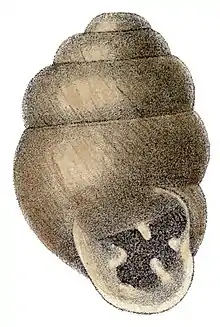Desmoulin's whorl snail
Desmoulin's whorl snail (Vertigo moulinsiana) is a species of minute air-breathing land snail, a terrestrial pulmonate gastropod mollusc or micromollusc in the family Vertiginidae, the whorl snails.[3]
| Desmoulin's whorl snail | |
|---|---|
 | |
 | |
| Vertigo moulinsiana Holotype MHNT | |
| Scientific classification | |
| Domain: | Eukaryota |
| Kingdom: | Animalia |
| Phylum: | Mollusca |
| Class: | Gastropoda |
| Subclass: | Heterobranchia |
| Order: | Stylommatophora |
| Family: | Vertiginidae |
| Genus: | Vertigo |
| Species: | V. moulinsiana |
| Binomial name | |
| Vertigo moulinsiana | |
| Synonyms | |
| |
This species was named in honor of the early-19th-century French naturalist Charles des Moulins.
Habitat
Desmoulin's whorl snail inhabits calcareous wetlands, where there are tall sedges, saw-sedge (Cladium mariscus), reed-grass (Glyceria maxima) or the reed Phragmites australis.[4]
.png.webp)
Distribution
The distribution of this species is Atlantic (the part of the Palearctic area which is under the direct climatic influence of the Atlantic Ocean), and southern-European.[5]
This small snail occurs across Europe as far north as southern Sweden.[6]
Within Western Europe, only the populations in England (Great Britain) and Ireland are considered to be viable,[6] although further populations exist in the Czech Republic (critically endangered, occupying the White Carpathians Biosphere Reserve, Kokořínsko Landscape Protected Area and Southern Moravia),[7][8][9] in Poland (critically endangered)[10] and elsewhere in Europe (for example: Netherlands,[11] France).[12] Its conservation status in the Czech Republic in 2004–2006 was described as favourable (FV) in the report for the European Commission in accordance with the Habitats Directive.[13] Its conservation status in Spain is endangered and it occurs in two localities only: near Estañá lake and near Lake of Banyoles.[14]
It is also found in Belgium, Switzerland, Italy, Germany, Austria, Slovakia, Hungary, Romania, Denmark, Norway, Finland, Latvia, Lithuania, Estonia, Belarus, Ukraine (Volhynia, critically endangered; around 2014 extinct in Crimea),[15][16] Russia, Georgia and Azerbaijan.[17] Its distribution also include Algeria and Morocco,[17] but it is possibly extinct in Algeria.[1]
This species is mentioned in Annex II of the European Union's Habitats Directive.[18]
Status in the United Kingdom
In the United Kingdom, Desmoulin's whorl snail is listed as endangered, although it occurs in a number of areas in a band from Norfolk to Dorset, with outlying populations in Kent and the Llŷn Peninsula in North Wales[6] and has probably been under-reported in the past because of its minute size. Its presence on the site of the planned Newbury bypass caused the building of that road to be postponed; the building works were able to go ahead once the snails had been moved to a new habitat nearby. It is reported to have since died out at the new site,[19][20] but the same report states "Desmoulin's whorl snail is now considered less scarce than it was 10 years ago".
Shell description
The shell is dextral, minute, ovate, ventricose, obtuse at the apex, smoothish, subperforate. The aperture is semiovate, four-toothed, with one tooth on the parietal wall, another on the columella, and two palatals, the lower one longer. The shell has four whorls, parted by a distinct suture, the last doubly larger than all the others together. It is rather solid, glossy, subpellucid and of a uniform fulvous color.[21]
The shell of this species reaches about 3 mm in length. The shell is yellowish or brownish and translucent.[22]
 Photo of the shell. |
 Drawing of the shell. |
On a stamp
Deutsche Post featured V. moulinsiana on a 2002 German €0.51 postage stamp as part of a series on endangered species of animals.[23]
References
This article incorporates public domain text from reference.[21]
- Killeen I., Moorkens E. & Seddon M. (2012). "Vertigo moulinsiana". In: IUCN 2012. IUCN Red List of Threatened Species. Version 2012.2. <www.iucnredlist.org>. Downloaded on 1 November 2012.
- Dupuy D. (1849). Catalogus extramarinorum Galliae testaceorum brevioribus specierum nondum descriptorum diagnosibus. pp. 1–4, p. 4, No. 248, Paris.
- MolluscaBase eds. (2023). MolluscaBase. Vertigo moulinsiana (Dupuy, 1849). Accessed through: World Register of Marine Species at: https://www.marinespecies.org/aphia.php?p=taxdetails&id=1050670 on 2023-02-10
- "Action plan for Vertigo moulinsiana". Joint Nature Conservation Committee. 2001–2007. Archived from the original on 27 September 2007. Retrieved 19 June 2007.
- (in Slovak) Lisický M. J. (1991). Mollusca Slovenska [The Slovak molluscs]. VEDA vydavateľstvo Slovenskej akadémie vied, Bratislava, 344 pp.
- "SAC selection species account: Desmoulin's whorl snail".
- "Evropsky významné lokality v České republice" (in Czech). 2003. Archived from the original on 27 September 2007. Retrieved 28 March 2007.
- "Red List of the molluscs (Mollusca) of the Czech Republic". 14 July 2006.
- Beran L. (2006). "New records of Vertigo moulinsiana (Gastropoda: Vertiginidae) and notes on its distribution and habitats in the Czech Republic" (PDF). Malacologica Bohemoslovaca. 5: 14–17.
- Pokryszko B. M. "Vertigo moulinsiana (Dupuy, 1849)". Instytut Ochrony Przyrody Polskiej Akademii Nauk.
- "Vertigo moulinsiana" (in Dutch). Stichting Anemoon. 2005.
- "Recherche de sites par espèce : Invertébrés : Vertigo moulinsiana (Vertigo moulinsiana)" (in French). Ministère de l’écologie et du développement durable. 2007. Archived from the original on 21 September 2007. Retrieved 14 May 2007.
- (in Czech) Dušek J., Hošek M. & Kolářová J. (2007). "Hodnotící zpráva o stavu z hlediska ochrany evropsky významných druhů a typů přírodních stanovišť v České republice za rok 2004–2006". Ochrana přírody 62(5): appendix 5:I-IV.
- Ramos M. A. (1998). "Implementing the habitats directive for mollusc species in Spain". Journal of Conchology, Molluscan Conservation: A Strategy for the 21st Century, Special Publication 2: 125–132.
- Balashov I. & Gural-Sverlova N. 2012. An annotated checklist of the terrestrial molluscs of Ukraine. Journal of Conchology. 41 (1): 91–109.
- Balashov I., Yarotskaya M., Filatova J., Starichenko I., Kovalov V. 2017. Terrestrial molluscs of the Tsyr-Pripyat area in Volyn (Northern Ukraine): the first findings of the threatened snail Vertigo moulinsiana in mainland Ukraine. Vestnik Zoologii. 51 (3): 251–258.
- Steffek J. (1996). "Vertigo moulinsiana". 2006 IUCN Red List of Threatened Species. IUCN. Retrieved 9 April 2007.
- "Council Directive 92/43/EEC of 21 May 1992 on the conservation of natural habitats and of wild fauna and flora". Official Journal of the European Union. European Union. L 206: 0007–0050. 22 July 1992.
- "Concern for Newbury bypass snail". BBC News. 27 July 2006.
- Weaver M. (27 July 2006). "End of the road for protected snail". The Guardian.
- Pilsbry H. A. & Cooke C. M. (1918–1920). Manual of Conchology. Second series: Pulmonata. Volume 25. Pupillidae (Gastrocoptinae, Vertigininae). Philadelphia. page 178.
- "Vertigo moulinsiana". ARKive. Archived from the original on 22 June 2006. Retrieved 19 June 2007.
- Bartl A. "Bauchige Windelschnecke" (in German). Archived from the original on 7 September 2012. Retrieved 14 May 2007.
- Dupuy D. (1849). Catalogus extramarinorum Galliae Testaceorum in opere cui titulus Histoire naturelle des Mollusques terrestres et d'eau douce qui vivent en France descriptorum. 4 pp.
- Sysoev, A. V. & Schileyko, A. A. (2009). Land snails and slugs of Russia and adjacent countries. Sofia/Moskva (Pensoft). 312 pp., 142 plates.
External links
- Vertigo moulinsiana at Encyclopedia of Life
- Vertigo moulinsiana at Animalbase taxonomy,short description, distribution, biology,status (threats), images
- Close-up photo of the shell of Vertigo moulinsiana

